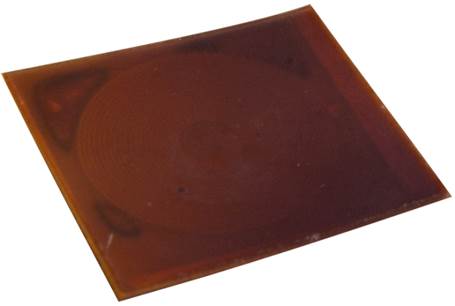Sensors & Actuators

A wireless chemical sensor using ferroparticles embedded hydrogel
Ferroparticle - hydrogel
Here, we present a wireless chemical sensor using ferroparticles-embedded hydrogel (ferrogel). Chemically triggered reversible swelling and de-swelling of ferrogel immobilized on top of a planar inductor results in a modulated inductance through two competing mechanisms; ferroparticle density and magnetic field passing through the volume-changing ferrogel. Overall, the effect of the magnetic flux passing through the ferrogel dominates, thus increasing the inductance as the ferrogel swells. The resulting inductance change can be remotely monitored through wireless tracking of the coil self-resonant frequency. A ph sensor based on poly (methacrylic acid-co-acrylamide) hydrogel was fabricated and tested. The test was carried out in a laser machine acrylic chamber with buffers of varying ph values flowing through while monitoring the resonant frequency with a network analyzer. The sensor shows sensitivity of 200 khz/ph between ph values of 6 to 5 and 105 khz/ph from 5 to 4 with approximately 30 minutes of response time.

Ferrofluid-Impregnated Paper Actuators
Ferrofluid - Paper
we report on an inexpensive method of fabricating miniature magnetic actuators using ferrofluid impregnated paper. Different types of papers (including soft tissue paper, cleanroom paper, Whatman-1 filter paper, printer paper, and newspaper) were loaded with oil-based ferrofluid, microma-chined by a CO2 laser and coated with a thin layer of parylene-C. The soaking capability of the different papers was investigated, with the soft tissue paper having the highest loading capacity, being able to absorb ferrofluid by as much as six times its original weight. Cantilever actuators fabricated from cleanroom and filter papers were able to generate the largest force (>; 40-mg equiva lent force), whereas the soft-tissue-paper cantilevers provided the greatest deflection (40° tip angle).
Publication
A Batch-Fabricated Laser-Micromachined PDMS Actuator with Stamped Carbon Grease Electrodes
We report on the development of a batch-fabricated laser-micromachined elastomeric cantilever actuator composed of a polydimethylsiloxane (PDMS) bilayer (active/inactive) and soft-lithographically patterned conductive carbon grease electrodes. The described unimorph structure has a low actuation voltage and large out-of-plane displacement. For a 4 mm long, 1 mm wide, and 80 µm thick actuator, an out-of-plane displacement of 1.2 mm and a maximum force of 25 µN were measured using 450 V actuation voltage.
Publication
Ocutack
G. Chitnis, B. Ziaie
This paper presents a novel minimally invasive implantable pressure sensing transponder for continuous wireless monitoring of intraocular pressure (IOP). The transponder was designed to make the implantation surgery simple while still measuring the true IOP through direct hydraulic contact with intra-ocular space. Furthermore, if situation demands (e.g., malfunction), implantation site allows physicians to easily retrieve the transponder. The device consists of three main components: 1) a hypodermic needle (gauge 30) penetrating sclera through pars plana and establishing a direct contact to the vitreous humor, 2) a micromachined capacitive pressure sensor connected to the needle back-end, and 3) a flexible polyimide coil connected in parallel with the capacitor forming a parallel LC circuit whose resonant frequency is a function of IOP. Most parts of the sensor sit externally on the sclera and only the needle penetrates inside the vitreous space through pars plana. In vitro tests showed a sensitivity of 15 kHz/mmHg with about 1 mmHg resolution. One month in vivo implants in rabbits confirmed biocompatibility, robustness, and functionality of the device.
Publications